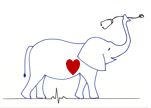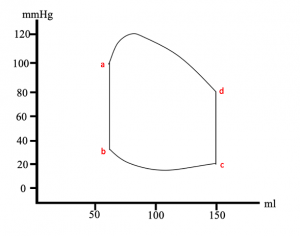Determinants of Cardiac Performance
1. Which of the following numbers corresponds with isovolumetric relaxation on the pressure volume loop?
a. 1
b. 2
c. 3
d. 4
e. 5
f. 6
2. Shown above is a pressure volume loop for the left side of the heart. At which point does the mitral valve close?
a. a
b. b
c. c
d. d
3. Which of the following best describes the concept of preload?
a. The pressure at the end of systole
b. Wall stress in diastole
c. The volume at the end of systole
d. Total mean pressure in peripheral circulation
4. A 13-year-old neutered male Pomeranian presents on emergency with signs of decompensated congestive heart failure, including difficulty breathing and pulmonary edema. Based on this presentation, you can guess that in this dog:
a. The sympathetic tone is low and the parasympathetic tone is high
b. The pulmonary capillary wedge pressure is likely elevated
c. An appropriate approach clinically would involve increasing afterload
d. The heart rate is likely slow to compensate for reduced contractility
5. Which of the following is generally true regarding determinants of cardiac performance in a healthy heart?
a. Increased preload tends to result in lower stroke volume and reduced cardiac output
b. Synergy of contraction refers to the simultaneous activation of the atria and ventricles on the same side of the heart
c. Increased afterload tends to result in higher stroke volume and increased cardiac output
d. Higher heart rate results in increased cardiac output, unless the heart rate is too fast to allow adequate filling


